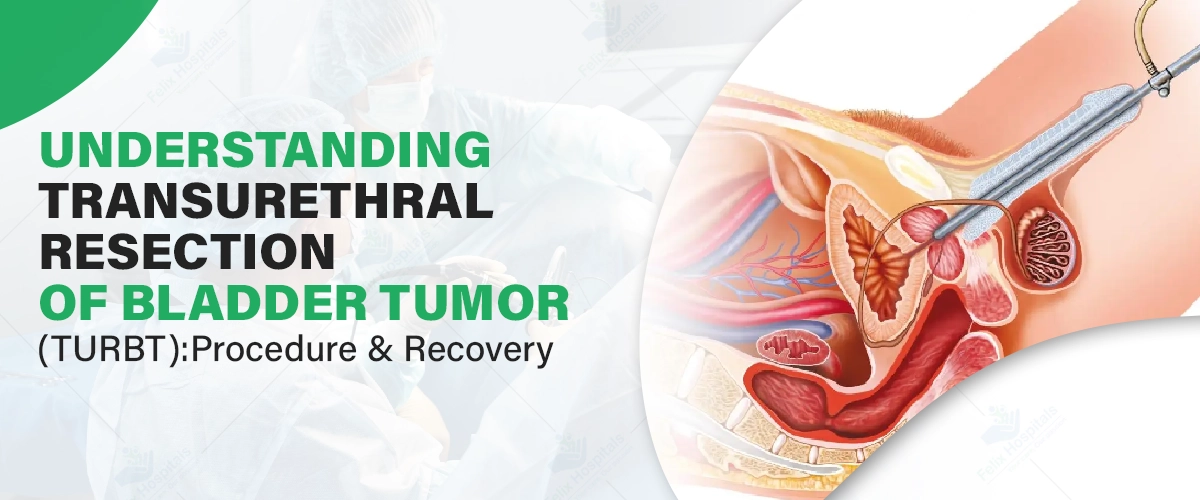
Subscribe to our

Bladder cancer is a prevalent health concern, affecting millions globally. It ranks among the most common types of cancer, especially in older adults. Early detection and treatment are critical for improving outcomes and minimizing complications. For patients diagnosed with bladder tumors, Transurethral Resection of Bladder Tumor (TURBT) is a standard and effective surgical procedure.
When it comes to bladder tumor treatment, choosing the best hospital in noida is vital. Renowned for their state-of-the-art facilities and expert specialists, are some of the best in the world for treating bladder tumors. Here, patients receive comprehensive care tailored to their needs.
Don’t wait—book your appointment now and experience world-class care for bladder tumor treatment. Call us at +91 9667064100.
Transurethral Resection of Bladder Tumor (TURBT) is a minimally invasive surgical procedure designed to remove abnormal growths or tumors from the bladder. Performed using a cystoscope—a thin tube equipped with a camera and surgical tools—the procedure allows surgeons to access and treat the bladder through the urethra, eliminating the need for external incisions.
The primary goal of TURBT is to diagnose and manage bladder tumors. It is typically employed for:
TURBT is recommended for individuals with symptoms or diagnostic results indicating bladder abnormalities. These may include:
Diagnostic procedures such as urine cytology, cystoscopy, and imaging confirm the need for TURBT, ensuring precise treatment planning.
Preparation is crucial for a successful TURBT procedure. Patients typically undergo:
The TURBT procedure involves several steps, typically performed under general or spinal anesthesia:
The procedure usually takes 60-90 minutes, depending on the complexity and size of the tumor.
While TURBT is generally safe, like any surgical procedure, it carries potential risks:
Recovery from TURBT is typically swift. Patients can expect:
Post-TURBT care includes:
TURBT is highly effective in treating non-muscle-invasive bladder tumors, often serving as the first line of defense against bladder cancer. The prognosis depends on factors such as tumor type, size, and stage. Early intervention, combined with diligent follow-up, significantly enhances long-term outcomes.
For world-class care, consult:
With extensive expertise in urology and bladder tumor treatments, Dr. Barkesia ensures each patient receives personalized and cutting-edge care. Recognized as one of the best doctors for bladder tumor management, he has transformed countless lives with his compassionate approach.
Your journey toward better health begins here. Contact Felix Hospital today and Click Here to schedule a consultation with our expert urologists.
TURBT is a cornerstone in bladder cancer management, offering a minimally invasive solution to diagnose and treat bladder tumors effectively. Early detection, timely intervention, and expert care can make a profound difference.
Felix Hospital provides unparalleled bladder tumor treatment at competitive costs, ensuring quality care for all. If you or a loved one faces a bladder tumor diagnosis, don’t hesitate to seek professional guidance and support. Together, we can fight bladder cancer and restore health.
Q- How long does it take to recover fully after TURBT?
Ans- Recovery typically takes 1-2 weeks, but full recovery may vary depending on the individual and the extent of the tumor.
Q- Is TURBT suitable for muscle-invasive bladder cancer?
Ans- TURBT is primarily used for non-muscle-invasive tumors. For muscle-invasive cases, additional treatments like chemotherapy or surgery may be required.
Q- Can TURBT completely cure bladder cancer?
Ans- TURBT is effective for removing tumors, but regular follow-ups are essential as bladder cancer has a recurrence risk.
Q- What dietary changes should I follow after TURBT?
Ans- A healthy, balanced diet with adequate hydration is recommended to promote healing and maintain bladder health.
Q- Are there alternatives to TURBT for bladder tumor removal?
Ans- While TURBT is the gold standard, advanced cases may require other interventions, such as radical cystectomy or immunotherapy.
Q- How often should I have follow-up check-ups after TURBT?
Ans- Typically, follow-ups include cystoscopies every 3-6 months initially, and the frequency decreases over time if no recurrence is detected.
Q- What precautions should I take post-surgery to avoid complications?
Ans- Avoid heavy lifting, follow your doctor’s instructions on medications, and maintain good hydration to support recovery.